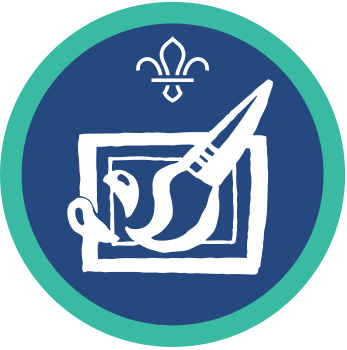
Try Tatreez Palestinian cross stitch
You’ll need
- Printed pattern template
- Printed cross stitch instructions
- 30cm x 30cm of Aida fabric ( gauze, linen or jute fabric can also be used)
- Coloured thread
- Scissors
- Sewing needle (blunt needle are best)
- Embroidery hoop (optional)
- Pencil
- Fabric colouring pens
- 30cm ruler
Before you begin
- Use the safety checklist to help you plan and risk assess your activity. Additional help to carry out your risk assessment, including examples can be found here. Don’t forget to make sure all young people and adults involved in the activity know how to take part safely.
- Make sure you’ll have enough adult helpers. You may need some parents and carers to help if you’re short on helpers.
Tatreez is Palestinian cross stitch using traditional motifs. Cross stitch is a type of sewing or embroidery that uses thread to make an X shaped stitch. Two stitches overlap to form a cross or X, with the X shapes all coming together to create a pattern or image. Cross-stich is usually done on fabrics that has small holes in it, such as aida. It can also be done on similar fabrics, such as gauze, linen or jute.
Tatreez is commonly used on garments and includes a variety of symbols including birds, trees and flowers. Geometric patterns and shapes are usually found in Tatreez cross stitch, too.
The craft was originally practiced in rural areas of Palestine, used to embroider clothes and fabrics, but it’s now common across wider Palestinian areas. In 2021, the art of embroidery in Palestine was recognised by UNESCO as an important intangible cultural heritage. Historically, each village in Palestine had their own Tatreez patterns. Every family had its own colours and patterns that they use. These patterns and colours were passed through generations and are used to identify which village in Palestine they come from. However, different styles of Tatreez became less distinct and have continued to evolve.
Setting up this activity
- Anyone doing this activity should have basic knowledge of how to do cross stitch.
- You should have printed copies of the activity template and stitching instructions, with enough for one per person or one per pair.
- The size of needle depends on size of the holes in the fabric you’re using. Needle sizes usually range from size 13 up to size 26. For example, a size 24 needle works well for 14 count Aida fabric.
- If you can’t find Aida fabric, you can use a similar fabric, such as gauze, linen or jute.
Run the activity
- Gather everyone together and ask if people have heard of cross stitch.
- Explain that you’re going to be doing Tatreez, a type of cross stitch that originates from Palestine and is usually done in a cross-stitch pattern.
- Tell everyone they’ll be doing cross-stitch. Cross stitch is a type of sewing or embroidery that uses thread to make an X shaped stitch. Two stitches overlap to form a cross or X, with the X shapes all coming together to create a pattern or image.
- Give everyone the fabric, a needle, embroidery thread, an embroidery hoop, pencil, and printed copies of the instructions and template.
- Everyone should find the centre of the fabric. You can do this by folding the fabric in half lengthwise first, then fold it in half width wise. You can then mark the centre point, where the two folds lines, meet with a pencil.
- When you look closely at your fabric, you can see small squares. Each square on your fabric represents a square on your pattern template. The centre point on your fabric matches to the centre point of your pattern template, so you can start stitching from this centre point.
- You may want to use an embroidery hoop. This is a double ring made of plastic, metal, or wood that secures your cross stitch as you work. You can secure the fabric into this hoop, making sure the centre point is placed in the middle.
- You'll stitch one cross stitch over each square on your fabric.
- When making the first few stitches remember to leave a 2cm ‘tail’ at the back of your work. Hold this ‘tail’ so that the first stitches are worked over it and this secures your thread evenly.
- Do not tie a knot in the thread.
- Cross stitch can be done in rows of even slanted stitches, from left to right’ laying down half the cross. Then back from right to let to complete them. The top stitch must be slanted.
- When stitching try to keep the tension of your thread even and do not pull too tight. It’s often easier to sew the design using an embroidery hoop to hold the fabric.
- To finish off your thread, run the needle through the back of four or five stitches and trim the thread close to the cloth.
Reflection
This activity let us try making a Tatreez pattern using cross-stitch.
Did you find anything easy or difficult while doing this activity?
Tatreez patterns are usually passed down in Palestinian families to identify which area of Palestine their family comes from. Do you have any patterns or sewing craft that is traditional in your family or from the area you live in?
Safety
All activities must be safely managed. You must complete a thorough risk assessment and take appropriate steps to reduce risk. Use the safety checklist to help you plan and risk assess your activity. Always get approval for the activity, and have suitable supervision and an InTouch process.
- Scissors
Supervise young people appropriately when they’re using scissors. Store all sharp objects securely, out of the reach of young people.
- Sharp objects
Teach young people how to use sharp objects safely. Supervise them appropriately throughout. Store all sharp objects securely, out of the reach of young people.
- To make the activity easier, mark the pattern template on the fabric using a pencil or coloured fabric markers before you begin stitching.
- To make this activity harder, you could try a more complex pattern.
- If anyone needs help or struggles with fine motor skills, give them the opportunity to work in pairs or small groups. They could also work with a young leader or an adult volunteer. The person they’re working with can help with the parts they find fiddly to do or tricky.
- You could have some of the fiddlier parts of the activity pre-done or pre-made for people to use, such as having items cut out or needles already threaded.
- Use wooden or plastic embroidery hoops to hold the fabric in place to make it easier for anyone who may struggle to hold the fabric sheet while threading. The embroidery hoops can offer extra grip.
- Arts and crafts activities can be done sitting or standing – whichever way works best for everyone. Make sure that all the materials are at a level that can easily be collected by and worked on by wheelchair users.
- If anyone struggles with fine motor skills, they could use larger materials. You could swap out the items for thicker threads or larger needles.
All Scout activities should be inclusive and accessible.
If you enjoyed this activity, why don’t you have a go at creating your own pattern and then cross-stitching it on to fabric?


